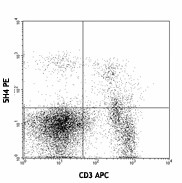- Clone
- 5H4 (See other available formats)
- Regulatory Status
- RUO
- Other Names
- IL-2 Receptor β chain, IL-2Rβ
- Isotype
- Rat IgG2a, κ

-

C57BL/6 mouse splenocytes stained with 5H4 PE and CD3 APC
| Cat # | Size | Price | Quantity Check Availability | ||
|---|---|---|---|---|---|
| 105905 | 25 µg | $86.00 | |||
| 105906 | 100 µg | $214.00 | |||
CD122 is a 70-75 kD IL-2 receptor β chain also known as IL-2Rβ, which is also shared by the IL-15 receptor. It is constitutively expressed by NK cells and at lower levels by T cells, B cells, monocytes, and macrophages. The IL-2Rβ chain can combine with either the common γ subunit (γc, CD132) alone or with the γc subunit and the IL-2Rα subunit (CD25) to generate intermediate or high affinity IL-2 receptor complexes, respectively. CD122 expression levels can be upregulated by activation. The 5H4 antibody does not block IL-2 binding to the IL-2 receptor. CD122 is expressed on murine, but not human, CD8+ Tregs involved in the maintenance of T cell homeostasis.
Product Details
- Verified Reactivity
- Mouse
- Antibody Type
- Monoclonal
- Host Species
- Rat
- Immunogen
- Rat myeloma YB2/0 transfected with truncated mouse Il-2Rβ cDNA
- Formulation
- Phosphate-buffered solution, pH 7.2, containing 0.09% sodium azide.
- Preparation
- The antibody was purified by affinity chromatography, and conjugated with PE under optimal conditions.
- Concentration
- 0.2 mg/ml
- Storage & Handling
- The antibody solution should be stored undiluted between 2°C and 8°C, and protected from prolonged exposure to light. Do not freeze.
- Application
-
FC - Quality tested
- Recommended Usage
-
Each lot of this antibody is quality control tested by immunofluorescent staining with flow cytometric analysis. For flow cytometric staining, the suggested use of this reagent is ≤ 0.25 µg per 106 cells in 100 µl volume. It is recommended that the reagent be titrated for optimal performance for each application.
- Excitation Laser
-
Blue Laser (488 nm)
Green Laser (532 nm)/Yellow-Green Laser (561 nm)
- Application Notes
-
Additional reported applications (for the relevant formats) include: immunoprecipitation1,2.
-
Application References
(PubMed link indicates BioLegend citation) -
- Furse R, et al. 1993 Eur. J. Immunol. 23:3181. (IP)
- He YW, et al. 1995. J. Immunol. 154:1596. (IP)
- Liqons DL, et al. 2012. J Biol Chem. 287:34386. PubMed.
- Product Citations
-
- RRID
-
AB_2125736 (BioLegend Cat. No. 105905)
AB_2125736 (BioLegend Cat. No. 105906)
Antigen Details
- Structure
- Ig superfamily, forms high affinity IL-2 receptor with CD25 and CD132 chains or intermediate affinity receptor with CD132 alone, 70-75 kD
- Distribution
-
T cells and B cells, NK cells, monocytes, macrophages
- Function
- Critical component of IL-2 and IL-15 signaling
- Ligand/Receptor
- IL-2, IL-15
- Cell Type
- B cells, Macrophages, Monocytes, NK cells, T cells, Tregs
- Biology Area
- Immunology
- Molecular Family
- CD Molecules, Cytokine/Chemokine Receptors
- Antigen References
-
1. Barclay A, et al. 1997. The Leukocyte Antigen FactsBook Academic Press.
2. Minami Y, et al. 1993. Annu. Rev. Immunol. 11:245.
3. Suzuki H, et al. 1995. Science 268:1472.
4. Shi Z, et al. 2009. Eur. J. Immunol. 39:2109. - Gene ID
- 16185 View all products for this Gene ID
- UniProt
- View information about CD122 on UniProt.org
Other Formats
View All CD122 Reagents Request Custom Conjugation| Description | Clone | Applications |
|---|---|---|
| Biotin anti-mouse CD122 (IL-2Rβ) | 5H4 | FC |
| PE anti-mouse CD122 (IL-2Rβ) | 5H4 | FC |
| Purified anti-mouse CD122 (IL-2Rβ) | 5H4 | FC,IP |
| TotalSeq™-A0227 anti-mouse CD122 (IL-2Rβ) | 5H4 | PG |
| APC anti-mouse CD122 (IL-2Rβ) | 5H4 | FC |
| TotalSeq™-B0227 anti-mouse CD122 (IL-2Rβ) | 5H4 | PG |
| TotalSeq™-C0227 anti-mouse CD122 (IL-2Rβ) | 5H4 | PG |
| Brilliant Violet 421™ anti-mouse CD122 (IL-2Rβ) | 5H4 | FC |
Compare Data Across All Formats
This data display is provided for general comparisons between formats.
Your actual data may vary due to variations in samples, target cells, instruments and their settings, staining conditions, and other factors.
If you need assistance with selecting the best format contact our expert technical support team.
-
Biotin anti-mouse CD122 (IL-2Rβ)

C57BL/6 mouse splenocytes stained with 5H4 PE and CD3 APC -
PE anti-mouse CD122 (IL-2Rβ)

C57BL/6 mouse splenocytes stained with 5H4 PE and CD3 APC -
Purified anti-mouse CD122 (IL-2Rβ)

C57BL/6 mouse splenocytes stained with 5H4 PE and CD3 APC -
TotalSeq™-A0227 anti-mouse CD122 (IL-2Rβ)
-
APC anti-mouse CD122 (IL-2Rβ)

C57BL/6 mouse splenocytes stained with NK-1.1 FITC and CD122... -
TotalSeq™-B0227 anti-mouse CD122 (IL-2Rβ)
-
TotalSeq™-C0227 anti-mouse CD122 (IL-2Rβ)
-
Brilliant Violet 421™ anti-mouse CD122 (IL-2Rβ)

C57BL/6 mouse splenocytes were stained with anti-mouse NK1.1...
